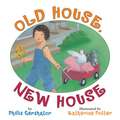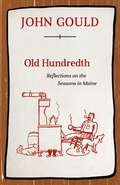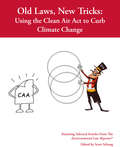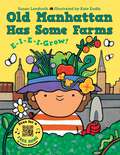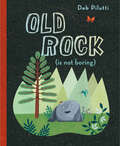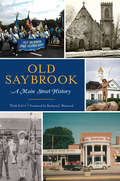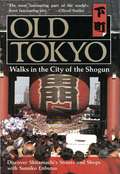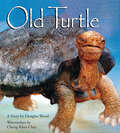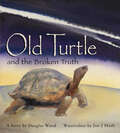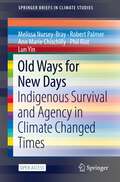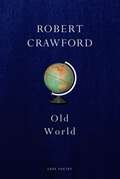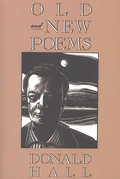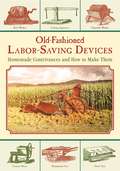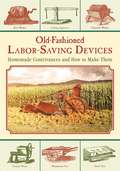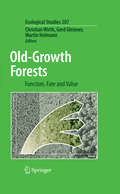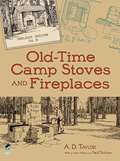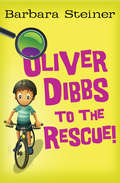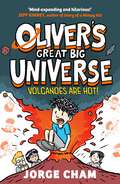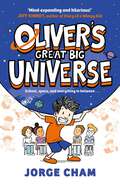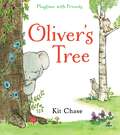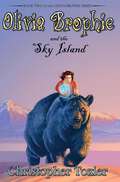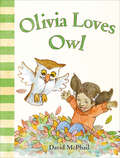- Table View
- List View
Old House, New House
by Phillis GershatorIt's summer, and a little girl likes moving into an old country house with a cranberry bog, a bullfrog creek, and farm animals that live down the road. But when fall comes, it's time to pack up and move again--all the way across the country to a new house in a new place with new friends and new adventures.
Old Hundredth: Reflections on the Seasons in Maine
by John Gould"You know that fall is here and winter comes soon when the summer people leave and Maine is restored to righteousness."So says celebrated essayist John Gould in this wonderful collection inspired by the changing of the seasons in Maine. These forty-nine essays revel in the seasonal magnificence the state has to offer and offer just enough humor, seasoned with country lore and wisdom to keep you turning the pages as you read in front of the wood stove on a cold winter afternoon.No wonder the critic Mark Kramer said, "If there is reincarnation, I'm selfish enough to wish that the next time around John Gould would come back as a writer again."
Old Law, New Tricks: Using the Clean Air Act to Curb Climate Change
by James Salzman David M. Driesen John Doyle Michael B. Gerrard Emily Taylor Robert B. Mckinstry Jr. Brigham Daniels Timothy Profeta Robert A. Wyman Robert D. Brenner Franz Litz Marie Ly Anna Marie Wood Scott H. Segal Institute for Policy Integrity Nathan Richardson Brooks Rainey Pearson Nicholas Bianco Leila B. Azari Richard B. Herzog Arnold W. Reitze Jr. Claudine Schneider Davonne Flanagan Nicholas W. Fels Jonas Monast Charles H. Haake Patricia A. Eberwine Scott Schang Gary S. Guzy Kristin Igusky Meek The National Climate Coalition Timothy J. Mullins Natural Resources Defense Council Art Fraas John C. Dernbach Thomas D. Peterson Dallas Burtraw Hannah Polikov Delavan Dickson Raymond B. Ludwiszewski M. Rhead Enion Curtis A. Moore Rebecca Gasper Hannah ChangFew if any people think the Clean Air Act is the optimal legislative solution to climate change; but it is a powerful tool that is being used sometimes despite the prevailing political will. To address this reality, this volume calls on the best writing from the most often-cited environmental law journal in the United States, the Environmental Law Reporter®, to explain the possibilities and pitfalls in using this regulatory framework to address greenhouse gases (GHGs) and short-lived climate pollutants. This collection does not have a singular perspective or agenda other than to highlight multiple suggestions about ways in which the Act should or should not be used to address climate change. The Environmental Law Institute and editors of Environmental Law Reporter® do not endorse any approach outlined in these pages but instead present various ideas to educate and spur public debate and discussion.
Old Manhattan Has Some Farms
by Susan LendrothA clever new spin on "Old MacDonald," this fun book explores the popular trend of urban farming. From rooftop farms and gardens on Manhattan high rises to neighborhood gardens in empty lots in Atlanta to hydroponic gardens in Seattle, growing food locally has become an important part of city-dwelling life.Set to the tune of the popular children's song, this bouncy rhyming text will get everyone reading (or singing) out loud. If you're not comfortable singing aloud, download the free recording of the song created by popular children's performer Caspar Babypants (aka Chris Ballew, lead singer and songwriter for the band The Presidents of the United States of America). Six North American cities are highlighted, but included in the back matter are tips and tricks on how to alter the text so you can sing about your own hometown gardens.Back matter also includes more information about the different types of gardens introduced, additional resources, and the sheet music for the song.
Old Rock (is not boring)
by Deb PiluttiQuirky charm infuses this tale of Old Rock's life story, which is much more exciting than you'd expect.Old Rock has been sitting in the same spot in the pine forest for as long as anyone can remember. Spotted Beetle, Tall Pine, and Hummingbird think just sitting there must be boring, but they are in for a wonderful surprise. Fabulous tales of adventurous travel, exotic scenery, entertaining neighbors, and more from Old Rock's life prove it has been anything but boring.Great storytellers come in all shapes, sizes, and ages, and Old Rock's stories are sure to inspire questions that lead to wonderful conversations about the past and the natural world.
Old Saybrook: A Main Street History (Brief History)
by Tedd LevyHere in this distinctive New England town, Main Street is the place to meet your neighbors, get a coffee, do your shopping, watch a parade, attend a concert, worship, vote or volunteer. And behind the familiar buildings is a colorful history. There's the humorist who organized his neighbors to buy land and build a town hall that later became the Katharine Hepburn Cultural Arts Center. The story of how the Monkey Farm got its name. The nighttime parade that draws thousands. And the heartwarming account of the shopkeeper who sent penny candy to students with good grades. Author Tedd Levy reveals the unique buildings, events, people and heritage of this distinctive thoroughfare.
Old Tokyo
by Sumiko Enbutsu Ryosuke Ishida"Sumiko Enbutsu, sure-footed and lively, leads us through Tokyo's old downtown. Sensitive to the character of each varied neighborhood, she brings a sharp eye to its half-hidden history, its traditional shops, and its most appealing restaurants. Old Tokyo is a boon to residents and visitors alike".
Old Tokyo
by Sumiko Enbutsu Ryosuke Ishida"Sumiko Enbutsu, sure-footed and lively, leads us through Tokyo's old downtown. Sensitive to the character of each varied neighborhood, she brings a sharp eye to its half-hidden history, its traditional shops, and its most appealing restaurants. Old Tokyo is a boon to residents and visitors alike".
Old Turtle
by Douglas WoodExperience the wisdom of Old Turtle, the bestselling fable that explores society, the environment, and the spirituality they share.Who is God?Is He a wind that is never still?Is He a rock that never moves?Is He high above or here among us?Venerable Old Turtle answers quietly: God is all of these things.Old Turtle first burst upon the publishing scene in 1992, and it was instantly recognized as a classic fable about ecology, peace, and the interconnectedness of all beings. Simple yet profound, it has since brought hope and inspiration to children and adults around the world.
Old Turtle and the Broken Truth
by Douglas WoodPowerhouse team Douglas Wood and Jon J Muth present a sequel to Old Turtle, the award-winning wisdom tale of peace and love for the earth.Seekers of all ages have been inspired by the stirring message of Old Turtle, the beloved, award-winning wisdom tale of peace. Now Old Turtle returns in a timeless story about love, acceptance, and the nature of truth.Long ago, as truth descended onto earth, it split in two: one piece landing among the people and the other blazing through the sky. When the people discover the piece of truth, it gives them strength and happiness. But over time, it turns them arrogant and greedy. They do not share their truth with others, wars rage on, and the earth begins to suffer. Then a Little Girl eager for change journeys to find Old Turtle, seeking the precious piece of wisdom that will mend the people's broken truth, making it -- and them -- whole once again.Douglas Wood's stirring and eloquent fable, soulfully illustrated in luminous watercolor by Jon J Muth, offers readers of all ages inspiration, hope, and a healing vision of peace.
Old Ways for New Days: Indigenous Survival and Agency in Climate Changed Times (SpringerBriefs in Climate Studies)
by Robert Palmer Melissa Nursey-Bray Ann Marie Chischilly Phil Rist Lun YinThis Open Access book provides a critical reflection into how indigenous cultures are attempting to adapt to climate change. Through detailed first-hand accounts, the book describes the unique challenges facing indigenous peoples in the context of climate change adaptation, governance, communication strategies, and institutional pressures. The book shows how current climate change terminologies and communication strategies often perpetuate the marginalisation of indigenous peoples and suggests that new approaches that prioritise Indigenous voices, agency and survival are required. The book first introduces readers to Indigenous peoples and their struggles related to climate change, describing the impacts of climate change on their everyday lives and the adaptation strategies currently undertaken to address them. These strategies are then detailed through case studies which focus on how Indigenous knowledge and practices have been used to respond to and cope with climate change in a variety of environments, including urban settings. The book discusses specific governance challenges facing Indigenous peoples, and presents new methods for engagement that will bridge existing communication gaps to ensure Indigenous peoples are central to the implementation of climate change adaptation measures. This book is intended for an audience of Indigenous peoples, adaptation practitioners, academics, students, policy makers and government workers.
Old World
by Robert CrawfordTraversing the globe, Old World is a generous, playful collection about the issues facing our planet today, from a major Scots poet and biographer of T.S. Eliot'For intellectual range, emotional depth, and lexical shimmer, Crawford is unsurpassed' Sunday HeraldMixing lyricism, play, and vulnerability, Old World explores the issues facing our planet in the twenty-first century, from European war to climate change and AI. From riddles and haikus to verse influenced by both Western and Eastern cultures, Crawford arrives at a sense of sacredness of life on earth.These poems speak both of the menaced plenitude of living beings, and of frailties associated with growing old. Part of the book is given over to voices of creatures from the non-human world, part to human voices, but boundaries between these categories become mischievously and disconcertingly unstable.‘A poet of great importance… fluent, inventive, funny, crackling with intellectual energy, and at the very heart of our own time’ Scotsman'In his hands, all modern life can be poetry’ Herald
Old and New Poems: Donald Hall
by Donald HallThis collection drawn from more than forty years of the poet’s work is “a superb introduction to newcomers and a sumptuous offering to familiars” (Publishers Weekly).Former US Poet Laureate Donald Hall has been celebrated with numerous awards, including the National Book Critics Circle Award and the National Medal of the Arts.This volume collects some of Hall’s finest short poetry written between 1947 and 1990. Here are poems of landscape and love, of dedication and prophecy.“Our delight is in following an exceptional poet's growth and depth as he emerges with a richly playful but consummately serious voice.” —Publishers Weekly
Old-Fashioned Labor-Saving Devices
by Skyhorse PublishingThe practical, intriguing American devices contained in this handbook come from an era long before milking machines, pesticide sprayers, and industrial hay balers. Designed to speed and simply everything from making your own butter to protecting drain outlets to organizing and storing tools, the easy-to-make mechanisms you'll find here can be just as useful for today's farmer as they were for frontier homesteaders.Discover how to transform odds and ends-scraps of lumber from old building projects, leftover sections of barbed wire, the box spring sitting in the attic-into handy household implements. With the illustrated instructions here, you can make a movable nest for hens, a ribless boat, a contraption to extricate a mired animal, a farm cart with movable racks for larger roads, a wire fence tightener, a fruit picker, a grindstone set and frame, and much more. This book is perfect for the rancher, farmer, craftsman-anyone with a love of the rural life.
Old-Fashioned Labor-Saving Devices: Homemade Contrivances and How to Make Them
by Skyhorse PublishingThe practical, intriguing American devices contained in this handbook come from an era long before milking machines, pesticide sprayers, and industrial hay balers. Designed to speed and simply everything from making your own butter to protecting drain outlets to organizing and storing tools, the easy-to-make mechanisms you’ll find here can be just as useful for today’s farmer as they were for frontier homesteaders.Discover how to transform odds and ends-scraps of lumber from old building projects, leftover sections of barbed wire, the box spring sitting in the attic-into handy household implements. With the illustrated instructions here, you can make a movable nest for hens, a ribless boat, a contraption to extricate a mired animal, a farm cart with movable racks for larger roads, a wire fence tightener, a fruit picker, a grindstone set and frame, and much more. This book is perfect for the rancher, farmer, craftsman-anyone with a love of the rural life.
Old-Growth Forests
by Christian Wirth Martin Heimann Gerd GleixnerMany terms often used to describe old-growth forests imply that these forests are less vigorous, less productive and less stable than younger forests. But research in the last two decades has yielded results that challenge the view of old-growth forests being in decline. Given the importance of forests in battling climate change and the fact that old-growth forests are shrinking at a rate of 0.5% per year, these new results have come not a moment too soon. This book is the first ever to focus on the ecosystem functioning of old-growth forests. It is an exhaustive compendium of information that contains original work conducted by the authors. In addition, it is truly global in scope as it studies boreal forests in Canada, temperate old-growth forests in Europe and the Americas, and global tropical forests. Written in part to affect future policy, this eminently readable book is as useful for the scientist and student as it is for the politician and politically-interested layman.
Old-Time Camp Stoves and Fireplaces
by Paul Dickson A. D. TaylorCreated during the Great Depression by the U.S. Forest Service, this guide was designed to provide environmental safety and maintenance advice for visitors to national forests and parks. Loaded with finely crafted drawings and plans for outdoor stoves and fireplaces, this manual offers a window into a bygone era of handyman activity as well as a wealth of still-useful information for building barbecue pits, chimneys, warming units, and other outdoor heating sources.Coverage includes considerations of general design problems and their solutions; discussion of detailed designs, from foundations to chimneys; construction materials, including iron, brick, concrete, stone, and sand; and specific types of camp stoves and fireplaces. Do-it-yourselfers interested in older construction techniques will find this volume a source of many tried-and-true ideas and methods.
Oliver Dibbs to the Rescue! (Oliver Dibbs #1)
by Barbara SteinerOliver just wants to spread the word about wildlife conservation, but his plans go awry when the local prairie dog habitat is threatenedOliver Dibbs is passionate about animals, and he&’s willing to do anything to help a good cause. The only problem is, Ollie doesn&’t always think his plans through before acting on them, and this has gotten him into a lot of trouble. No matter what cause Ollie is fighting for—whether it&’s tigers, wolves, or whales—something always goes wrong. It doesn&’t help that his little brother, Bo, always wants to tag along. It&’s hard to look out for a seven-year-old and save the world at the same time.But when Ollie finds out a local businessman is planning to build a shopping mall right over the town&’s prairie dog habitat, he knows that he can&’t fail. If he doesn&’t step in and protect the prairie dogs&’ home, they&’ll all die. This time, Ollie has to make sure nothing stands in his way!
Oliver Dibbs to the Rescue! (Oliver Dibbs #1)
by Barbara SteinerOliver just wants to spread the word about wildlife conservation, but his plans go awry when the local prairie dog habitat is threatenedOliver Dibbs is passionate about animals, and he&’s willing to do anything to help a good cause. The only problem is, Ollie doesn&’t always think his plans through before acting on them, and this has gotten him into a lot of trouble. No matter what cause Ollie is fighting for—whether it&’s tigers, wolves, or whales—something always goes wrong. It doesn&’t help that his little brother, Bo, always wants to tag along. It&’s hard to look out for a seven-year-old and save the world at the same time.But when Ollie finds out a local businessman is planning to build a shopping mall right over the town&’s prairie dog habitat, he knows that he can&’t fail. If he doesn&’t step in and protect the prairie dogs&’ home, they&’ll all die. This time, Ollie has to make sure nothing stands in his way!
Oliver's Great Big Universe: A Times Children's Book of the Week (Oliver's Great Big Universe #2)
by Jorge Cham&‘Mind-expanding and hilarious!&’ Jeff Kinney, author of the bestselling DIARY OF A WIMPY KID series.'A brainy guide to the barfs, farts and burps of Planet Earth.' The TimesThe second book in the hilarious series that makes you laugh-out-loud AND grows your brain. Perfect for readers age 8+ and fans of Diary of a Wimpy Kid and The 13-Storey Treehouse. Hi, I&’m Oliver! Writing a book has made me kind of a celebrity around school – no big deal. But does that mean everything is perfect? No way! I&’m still trying to figure out the usual stuff: school cliques, weird family, and how to finally win the science fair. While I may know EVERYTHING about space, there&’s a lot to learn about the planet we live on, like: volcanic burps and bacteria farts how the Earth&’s layers are like boba tea aliens! (Are we the aliens?) From bestselling writer and robotics engineer Jorge Cham, Oliver&’s Great Big Universe: Volcanoes Are Hot! is the second book in a STEM-themed, diary-style series.
Oliver's Great Big Universe: the laugh-out-loud new illustrated series about school, space and everything in between!
by Jorge Cham&‘Mind-expanding and hilarious!&’ Jeff Kinney, author of the bestselling DIARY OF A WIMPY KID series. This hilarious new illustrated series will make you laugh-out-loud AND grow your brain. Perfect for readers age 8+ and fans of Diary of a Wimpy Kid and The 13-Storey Treehouse. Hi, I&’m Oliver! I know what you&’re thinking: what does an 11-year-old kid know about the universe? Am I a famous scientist? No. Am I a super-genius? Not really. I&’m just trying to figure out the usual stuff: new school, new friends, how to avoid my annoying sister. But there&’s one thing that DOES make sense: science! Outer space is totally my thing and I can tell you EVERYTHING you need to know about awesome stuff like: time-bending black holes how the Big Bang is like a fart aliens! (Well, there could be aliens.) From bestselling writer and robotics engineer Jorge Cham, Oliver&’s Great Big Universe is the first book in a STEM-themed, diary-style series. &‘An absolute gem!&’ Lincoln Peirce, author of the bestselling series BIG NATE. &‘A stellar confluence of comic episodes and cosmic information. In addition to brilliantly integrated comic moments – surprising plot twists add narrative pizzazz to a serious raft of data about the universe. An irresistibly entertaining introduction to astrophysics.&’ – Kirkus starred review &★
Oliver's Tree
by Kit ChaseMeet three adorable best friends from debut author/illustrator talent with a huge Etsy following Oliver, Charlie, and Lulu love to play outside together. Their favorite game is hide-and-seek, but it’s not fun for Oliver when his friends hide in the trees—he can’t reach them! So the friends set off to find a tree that Oliver can play in.But there’s a reason we don’t see elephants in trees, and just when Oliver is ready to give up the search, Charlie and Lulu surprise him with the perfect tree for them all to play in together!
Olivia Brophie and the Sky Island
by Christopher TozierOlivia's life is in turmoil ever since she accidentally froze all of the world's water and her aunt and uncle were kidnapped by the Wardenclyffe thugs. With the help of a black bear named Hoolie, she must travel across America to undo the damage she caused. Hungry and wounded, she stumbles into a secret valley invisible to the outside world. There she meets an ancient civilization with no intention of letting her leave. In the meantime, Doug and Gnat are drawn deeper into the world of Junonia, the mysterious city built in the aquifer beneath Florida. Doug works diligently to scientifically document the discovery of giant tardigrades when his secret is accidentally revealed to the last person in the world he wanted to tell, Larry Mutch. Caught in an epic battle, Doug must find a way to save himself, Gnat, and the bully who doesnt want his help.See all of the books in this series
Olivia Loves Owl (David McPhail's Love Series)
by David McPhailA companion to Ben Loves Bear, Bella Loves Bunny, and Peter Loves Penguin, Olivia Loves Owl features a little girl and her beloved stuffed owl. Olivia and Owl pick apples and frolic through piles of colorful leaves. After enjoying a perfect fall day, they go inside to wish upon a star and hoot at the moon. The youngest readers will relate to the loving bond between a child and her favorite stuffed animal and how this sweet friendship makes each day special.
Olivia's Birds Saving the Gulf: Saving The Gulf
by Olivia BoulerOne 11 year-old girl can make a difference-as budding ornithologist and artist Olivia Bouler has proven, single-handedly raising over $175,000 for the Gulf Coast oil spill recovery. Devastated by the disaster and eager to do her part, Olivia wrote a letter to Audubon, "11 years old and willing to help" offering her own bird paintings to raise contributions for Gulf recovery efforts. The idea took flight, and Olivia proceeded to send out over 500 paintings, many of which are captured in this lavish picture book that recaps her valiant campaign to save birds affected by the spill.
